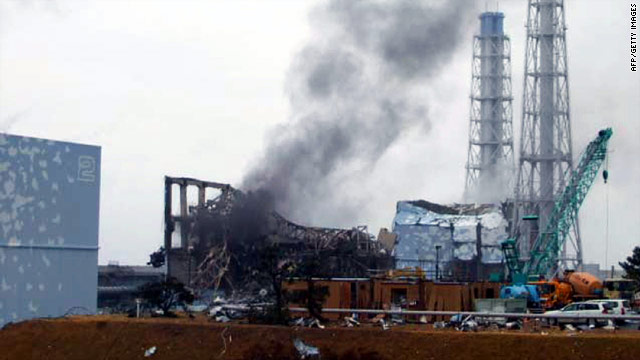
#3 reactor. More than a paint job required.
They've just said that all workers have been withdrawn from the site following the emergence of black smoke.
I wonder what it will take for the pro-nuclear lobby to admit that there may be a problem.
Moderator: Peak Moderation

http://www.zamg.ac.at/docs/aktuell/Japa ... 1500_E.pdfFirst emission estimates
In the phase of March 12 to 13, the Fukushima emissions were mostly transported to the Pacific, eventually hitting the CTBTO
station in Sacramento/California. In the phase March 14 to 15, on the other hand, most of the emissions were transported inland,
hitting the CTBTO station in Takasaki, Japan. Based on simulated dilution factors and measurements, we were able to have a first
rough source estimate.
Regarding Iodine-131, the picture is relatively homogeneous. A source term of 10^17 Bq per day would explain the measurements in
Takasaki as well as Sacramento. The total 4-day emission of 4x10^17 Bq is on the order of 20% of the total emissions of Iodine-131
that occurred during the Chernobyl accident. Regarding Cesium-137, the situation is a bit different. In the cloud eventually
propagating to the United States, the ratio of Iodine-131 to Cesium-137 was about 30. This is similar to the Chernobyl accident. In
Takasaki, however, this ratio was four. This would indicate a much larger Cesium-137 release in the second two-day period after
the accident. Taking this together, the source terms would be about 3x10^15 Bq during the first two days, and 3x10^16 during the
second two-day period. In sum, this could amount to about 50% of the Chernobyl source term of Cesium-137.
Who said there isnt a problem?biffvernon wrote:I wonder what it will take for the pro-nuclear lobby to admit that there may be a problem.
Why are the Japanese making such a big fuss about dealing with the power stations? Surely if there was no problem they could just let them burn themselves out or whatever, and clean up the mess sometime in the future, when they've got the country up and running again.DominicJ wrote:What there isnt, is a catastrophe, a disaster, a calamity, an apocalypse, or any of the other weird and wonderful words.
Well, of course, there are those things, but not nuclear ones.
http://english.kyodonews.jp/news/2011/03/80539.htmlNeutron beam observed 13 times at crippled Fukushima nuke plant
TOKYO, March 23, Kyodo
Tokyo Electric Power Co. said Wednesday it has observed a neutron beam, a kind of radioactive ray, 13 times on the premises of the Fukushima Daiichi nuclear plant after it was crippled by the massive March 11 quake-tsunami disaster.
TEPCO, the operator of the nuclear plant, said the neutron beam measured about 1.5 kilometers southwest of the plant's No. 1 and 2 reactors over three days from March 13 and is equivalent to 0.01 to 0.02 microsieverts per hour and that this is not a dangerous level.
The utility firm said it will measure uranium and plutonium, which could emit a neutron beam, as well...
One of the reactors in the crippled Fukushima nuclear plant may have been relying on flawed steel to hold the radiation in its core, according to an engineer who helped build its containment vessel four decades ago.
The Daily Hate reports that 5 workers have died and 15 hospitalised - not seen that reported elsewhere, so I'd take that with a Potassium Iodide tablet - for now at least.NKH wrote: Japan's nuclear safety agency says 2 workers at the Fukushima Daiichi nuclear power plant were taken to hospital on Thursday after being exposed to high-level radiation at the Number 3 reactor.
NHK
An NHK helicopter crew has confirmed what appears to be steam rising from No. 1, 2, 3 and 4 reactor buildings at the troubled Fukushima Daiichi nuclear power plant.
More fro NHK
http://www.newscientist.com/article/dn2 ... evels.htmlJapan's damaged nuclear plant in Fukushima has been emitting radioactive iodine and caesium at levels approaching those seen in the aftermath of the Chernobyl accident in 1986. Austrian researchers have used a worldwide network of radiation detectors – designed to spot clandestine nuclear bomb tests – to show that iodine-131 is being released at daily levels 73 per cent of those seen after the 1986 disaster. The daily amount of caesium-137 released from Fukushima Daiichi is around 60 per cent of the amount released from Chernobyl.
The Guardian - 24/03/11
The very human heroes of Fukushima
That plant workers are still risking their lives to help others seems to owe less to the selfish gene, more to ancestral culture.
Article continues ...